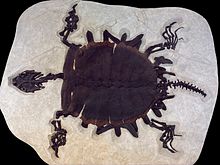Axestemys is an extinct genus of softshell turtle that lived from the Late Cretaceous to the Eocene in western North America and Europe.
| Axestemys Temporal range:
| |
|---|---|

| |
| A. byssina | |
| Scientific classification | |
| Domain: | Eukaryota |
| Kingdom: | Animalia |
| Phylum: | Chordata |
| Class: | Reptilia |
| Order: | Testudines |
| Suborder: | Cryptodira |
| Family: | Trionychidae |
| Subfamily: | Trionychinae |
| Genus: | †Axestemys Hay, 1899 |
| Species | |
| |
| Synonyms | |
| |
Axestemys, like its modern relatives, had no scutes on its carapace, which probably had leathery, pliable skin at the sides. Despite living several million years ago, Axestemys would have looked very similar to its modern relatives, with a long neck, a sharp beak, and three toes on each foot.[1] All species of Axestemys grew to a large size, especially A. byssina, that could reach a total length of 2 metres (79 in) or more, being larger than any modern day species of softshell turtle.[2] Based on the diet of modern softshell turtles, it was an omnivore, eating water plants, invertebrates, and perhaps small fish.[1]

A specimen of A. splendida was identified when a study by Victoria Megan Arbour et al. proposed that the presumed Dakotaraptor furculae in fact represented a part of a turtle’s armor, the entoplastron of Axestemys splendida, a member of Trionychidae.[3] In 2016, DePalma et al. recognized that none of the referred furculae actually belonged to Dakotaraptor and excluded them from its hypodigm.[4]
See also
edit- Drazinderetes, another enormous trionychid
- Stupendemys, a giant prehistoric freshwater side-necked turtle
- Archelon, a giant sea turtle of the Cretaceous
- Largest prehistoric animals
References
edit- ^ a b Palmer, D., ed. (1999). The Marshall Illustrated Encyclopedia of Dinosaurs and Prehistoric Animals. London: Marshall Editions. p. 69. ISBN 1-84028-152-9.
- ^ Grande, Lance (14 June 2013). The Lost World of Fossil Lake: Snapshots from Deep Time. p. 200. ISBN 9780226922966.
- ^ Arbour, V.M.; Zanno, L.E.; Larson, D.W.; Evans, D.C.; Sues, H. (2015). "The furculae of the dromaeosaurid dinosaur Dakotaraptor steini are trionychid turtle entoplastra". PeerJ. 3: e1957. doi:10.7717/peerj.1691. PMC 4756751. PMID 26893972.
- ^ DePalma, R.A.; Burnham, D.A.; Martin, L.D.; Larson, P.L.; Bakker, R.T. (2016). "Corrigendum to: The First Giant Raptor (Theropoda: Dromaeosauridae) from the Hell Creek Formation". Paleontological Contributions. 16. doi:10.17161/1808.22120. hdl:1808/22120.
Further reading
edit- Natasha S. Vitek (2012). "Giant fossil soft-shelled turtles of North America". Palaeontologia Electronica. 15 (16): 1–43. doi:10.26879/299.
- Walter G. Joyce, Donald B. Brinkman and Tyler R. Lyson (2019). "A new species of trionychid turtle, Axestemys infernalis sp. nov., from the Late Cretaceous (Maastrichtian) Hell Creek and Lance formations of the Northern Great Plains, USA". Palaeontologia Electronica. 33 (3): 1–28. doi:10.26879/949.